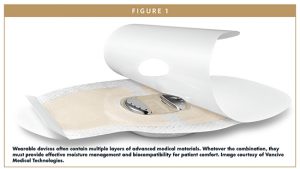Issue:October 2019
WEARABLE DEVICES - Wearable Drug Delivery Applications: Considerations for Adhesive Material Selection & Wear Testing
ABSTRACT
Wearable drug delivery applications can offer many patient care benefits, from easy administration to around-the-clock monitoring and medication management. However, if the device cannot comfortably and reliably be worn for the prescribed time period, it cannot deliver optimal outcomes. Also, as developers seek longer wear times to strengthen their devices’ economic model, they need a clear understanding of how device design, construction, and adhesive material selection can be best aligned for extended wear solutions.
The following will discuss the broader healthcare and digital health landscape behind wearable device developments and provide a brief overview of two types of wearable applications — insulin pump therapy/continuous glucose monitoring (CGM) systems and wearable drug injectors. It will then focus on important considerations for adhesive material selection and wear testing of wearable drug delivery devices.
EVOLVING HEALTHCARE PARADIGMS
Behind the growth of wearable drug delivery applications are a powerful duo of drivers: lowering healthcare costs and increasing patient convenience. The healthcare industry is undergoing a transformation as players across its ecosystem strive to identify and adapt to less-expensive modes of care delivery.
“It is hard to dispute the notion that the mission of today’s health systems, predominantly hospital-centric throughout the past 50+ years, is undergoing a significant transformation. Some might even refer to the transformation as happening at warp speed compared to the historically modest rates of change seen throughout the past few decades,” said Brent McDonald, Head of Healthcare Strategic Advisory Services and Managing Director at Bank of America Merrill Lynch. Among factors impacting legacy healthcare systems, McDonald pointed to “the decrease in in-patient utilization due to technology and increase of other lower-cost and more convenient ambulatory/outpatient care settings.”1
One of the most important lower-cost care settings is the patient’s home. Telemedicine, whereby patients engage with their healthcare providers remotely, is on the rise. A Global Market Insight report valued the telemedicine market at $38.3 billion in 2018 and projected it will reach $130.5 billion by 2025. A Doximity study found telemedicine visits increased annually by 261% between 2015 and 2017. Factors prompting this growth include the physician shortage, more insurance reimbursement for telemedicine services, improved technology, and evidence of efficacy.2
Telemedicine is one component of a changing healthcare industry enabled by the Internet of Medical Things (IoMT). The Deloitte Centre for Health Solutions defined the IoMT as “a connected infrastructure of medical devices, software applications and health systems and services” in its 2018 report, “Medtech and the Internet of Medical Things: How connected devices are transforming healthcare.” MarketsandMarkets valued the IoMT market at $41.2 billion in 2017 and expected it to rise to $158.1 billion in 2022, according to the Deloitte report. Of that total, the connected medical device segment is predicted to grow from $14.9 billion in 2017 to $52.2 billion in 2022. As an IoMT market application, medication management was valued at $6.6 billion in 2017.3
“The rise of the IoMT comes at a time when healthcare is becoming increasingly expensive, with global healthcare spending expected to grow 4.2% per year, from $7.1 trillion in 2015 to $8.7 trillion by 2020, largely due to a growing and ageing population, with more people living longer but with multiple comorbidities. As a result, without radical transformation, healthcare in many countries risks becoming increasingly unaffordable,” said the Deloitte report
Nestled amid the big picture of telemedicine and the IoMT is growth in self-administration of medications at home. When the patient’s home is the drug delivery location, as opposed to a hospital or out-patient care facility, costs are lower. These savings are increasingly in the sights of pharmaceutical developers whose therapies already are quite expensive. There is a compelling impetus for them to develop drug formulations suited to self-injection instead of intravenous (IV) administration. “Recent years have seen groundbreaking advances in pharmaceutical development, with increasingly innovative medicines being brought to market every day. However, the cost and complexity of these novel drugs has intensified the pressure to shift medication administration from traditional settings to more cost-effective alternatives. One such alternative is the patient’s own home, where life-altering molecules are now regularly self-administered subcutaneously to treat chronic diseases, such as rheumatoid arthritis, multiple sclerosis, and dyslipidemia among others,” said Beth DiLauri, Director of Strategic Marketing, BD Medical, Pharmaceutical Systems, in a recent Drug Delivery & Development article, Wearable Injectors – BD Wearable Drug Delivery Devices: An Attractive Proposal.4
INSULIN DELIVERY SYSTEMS & WEARABLE INJECTORS OVERVIEW
Insulin Delivery Systems
Body-worn insulin delivery systems, including those with integrated CGM capabilities, are designed to help individuals with diabetes to manage this prevalent and costly chronic disease. An estimated 1.5 million people are diagnosed with diabetes in the US each year, according to the American Diabetes Association. The disease affects approximately 30.3 million Americans, or 9.4% of the population. Diabetes has a US economic cost of $327 billion, including $237 billion in direct medical costs and $90 billion in reduced productivity.5
Insulin delivery solutions come in many different shapes, sizes, and configurations. The most advanced are closed-loop systems, which act as a sort of artificial pancreas – continually monitoring the patient’s glucose levels, administering insulin as needed, and alerting the patient of low- or high-glucose events. These systems have three primary components:
- A body-worn sensor that measures glucose levels in the skin’s interstitial fluid, usually by way of a tiny needle on the sensor’s skin-facing side.
- A transmitter, often integrated into the body-worn sensor, which sends the glucose data to a digital device, such as a smart phone or automated insulin dosing (AID) system receiver. These systems feature dosing algorithms that determine whether the patient needs insulin, and they may communicate directly with an insulin delivery device.
- An insulin pump or pod that delivers the insulin into the patient’s body, usually through a small cannula.
Dexcom, maker of the G6® Integrated Continuous Glucose Monitoring (iCGM) System, markets the technology, in part, by promoting how it provides an ongoing story versus a snapshot of the patient’s glucose levels throughout the day and alleviates the need to do fingerpricks as frequently to check blood glucose levels. The Dexcom system integrates with Tandem Diabetes Care’s t:slimX2TM insulin pump and Insulet’s OmniPod Insulin Management System.6 Medtronic, maker of the MiniMedTM 670G system with Smart-GuardTM technology, said its system “automatically adapts to [the patient’s] unique insulin needs every 5 minutes.”7 Abbott is the developer of the FreeStyle Libre CGS system, which it has plans to integrate with a new insulin pen from Novo Nordisk as well as Bigfoot Biomedical’s insulin delivery solutions.8,9
Diabetes care may be only the beginning for wearable drug delivery systems with continuous monitoring. MobiHealth News reported in July 2019 that Abbott Executive Vice President of Finance and CFO Brian Yoor had this to say about other potential applications for FreeStyle Libre technology on a Q2 2019 earning calls: “I think [Libre has] got enormous potential, and it’s got potential beyond glucose. It’s got potential as a wearable and other analytes and other products over time. We have R&D programs underway not only for the repeated enhancements, improvements, expansion of Libre, but also into other categories beyond diabetes. I think there’s a lot of things that’ll evolve over the coming years that today people aren’t even contemplating with the product.”10
Wearable Injectors
Pharmaceutical companies and wearable medical device developers also are investing more R&D into formulations and device formats for wearable drug injectors, also known as on-body wearable injectors. The global market for wearable injectors is expected to grow from $5.57 billion in 2018 to $9.41 billion by 2023, according to MarketsandMarkets, which cites drivers including:
-increased prevalence of chronic diseases, such as cancer, diabetes, and cardiovascular disease
-more favorable reimbursement in major markets
-technology advances11
Wearable large-volume injectors (LVI) are a type of wearable injector that typically hold at least 2 mL of a drug. In a wearable injectors update published in ONdrugDelivery, Paul Jansen, Associate Vice President, Medical Device Development, Subcujet, predicted most LVI development will be in devices holding 3 mL to 10 mL. He said more than 3,000 injectable drugs are in development.12
In an overview for its December 2018 LVI research report, Roots Analysis said, “[LVI] are capable of drug delivery primarily via the subcutaneous route and have become a preferred choice for administration of drugs in the home-care setting.”13
FACTORS AFFECTING WEAR TIME
Many wearable drug delivery device developers are seeking extended wear times. The economic case for a device often becomes stronger with longer wear times because there is not as much replacement cost. Extended wear times also can enhance patient convenience and compliance with a drug treatment plan. If a wearable device stays in position for extended periods, then there is less onus on the patient to remember to take his or her medication or to stop daily life activities to change out their drug delivery system sensor or injector. Whereas around 3 to 7 days previously was the wear-time norm, today, it is common for device developers to aim for 21- or 28-day wear times.
In recent years, there have been significant improvements in wearable device battery performance and other electronic and computing capabilities. Before these advances, a device’s wear time often was dictated by battery life or data storage limits. Now, adhesive material suppliers are focused on offering skin-friendly solutions that keep pace with extended wear times made possible by progress in other areas.
From an adhesive material perspective, a few of the most important factors affecting device wear time are moisture management, biocompatibility, and device design and construction. Each of these variables relate to one overarching goal: patient comfort.
Moisture Management
If moisture from perspiration or contact with fluids gathers on the skin beneath the wearable drug delivery system, the patient is likely to feel uncomfortable and could experience skin deterioration. This could lead the patient to remove the device prematurely or to experience an adverse event, such as a skin tear or infection. Most adhesive materials manage moisture in one of two ways. Either they absorb moisture and hold it away from the skin (fluid absorption), or they allow the moisture to pass through tiny pores in the material and evaporate (moisture vapor transmission). Some advanced medical materials leverage both moisture management methods.
Biocompatibility
If there are any irritants in the adhesive, the skin under the body-worn device can become itchy, red, or painful. Drug delivery system developers will want to be sure adhesive materials pass the ISO 10993 standard tests for cytotoxicity, irritation, and sensitivity, plus comply with local regulations by global region, and address allergen concerns relevant to the specific device end use.
Device Design & Construction
Adhesive material suppliers with wearable medical device experience can collaborate with drug delivery system developers on design and construction strategies to help ensure patient comfort as well as device manufacturability. For example, it is critical for the device construction to feature compatibility between skin-contact layer adhesives and construction-layer adhesives. The construction-layer material, also known as the tie-layer adhesive, is used to connect the skin contact layer to the device casing. Tie-layer materials often are double-sided adhesive tapes engineered to adhere properly to the skin-contact layer on one side and the device housing material (such as plastic) on the other. If the tie-layer tape’s carrier material is non-porous, it can hinder or cancel the effectiveness of a porous (breathable) skin-contact layer material. In this case, it may be best for the device maker to use an absorbent skin-contact material. An experienced adhesive materials supplier can help recommend the appropriate mix of materials for the wearable drug delivery device application.
The adhesive release liner can also play an important role in manufacturability, device shelf-life, and the patient experience. An advanced adhesive materials supplier can advise device developers about which combination of adhesive and release chemistries will help their product to run most efficiently through roll-to-roll manufacturing lines. Release liners provide crucial support to delicate adhesive materials during production processes, such as rewinding, slitting, and die cutting. In addition, the materials supplier can recommend the best liner solution to properly protect the adhesive material through the device manufacturer’s preferred sterilization method. Not all release chemistries are designed to withstand the same sterilization procedures. The liner also must remain securely in place, continuing to maintain the adhesive’s integrity, through transportation and storage, and then be easy to remove by the patient.
WEAR TESTING OF DEVICE CONCEPTS
Even with the most thoughtful and collaborative approach to wearable device material selection and design, there is no substitute for wear testing a device concept to see how it feels and functions in actual use. Ideally, this testing, or “try storming,” should take place during the early product conceptualization stage before the design freeze. Some materials suppliers will conduct this type of wear testing for customers to help identify optimal material choices and design elements — and to expose any unexpected problems with comfort and adherence.
A typical wear study, with appropriate statistical rigor, will involve a group of human volunteers that wear a device prototype (incorporating different material combinations) for the desired wear time, whether 7, 14, or 21 days or longer. Study participants can expose the device to different levels of activity, such as exercise and showering.
Sometimes the same group of people will then test a different device (one made with different materials or of a different design/construction) in order to offer a comparison of the wear experience. In other cases, the same device may be tested on some subjects worn on one part of the body (ie, abdomen) and tested on others worn on another area (ie, upper arm). Different body areas perspire at varied rates, and the amount of skin stretching and twisting can also vary widely. Results can then be useful in unlocking the optimum design for the wearable product.
SUMMARY
As healthcare transforms to become more convenient, affordable, and effective for more people, connected medical device solutions will play an increasingly important role. Wearable drug delivery systems enable patients to more easily monitor their conditions and self-administer medications in the comfort and privacy of their homes. The most successful wearable devices will offer extended wear times and a high degree of comfort and discretion.
To this end, adhesive material selection matters a great deal. Wear testing during product conceptualization can help prove or disprove hypotheses regarding which material combinations, design elements, or application sites will be most comfortable and feasible for the end user. Sometimes this type of testing can expose issues that might be impossible to anticipate without a wear trial.
REFERENCES
- HealthLeaders. Navigating the M&A landscape: achieving clinical and financial objectives. https://interactive.healthleadersmedia.com/Navigating-M-A-Landscape-Intel. Published April 2019. Accessed July 23, 2019.
- Lagasse J. Telemedicine is poised to grow as its popularity increases among physicians and patients. Healthcare Finance. July 24, 2019. https://www.healthcarefinancenews.com/news/telemedicine-poised-grow-its-popularity-increasesamong-physicians-and-patients. Accessed July 25, 2019.
- Ronte H, Taylor K, Haughey J; for Deloitte Centre for Health Solutions. Medtech and the internet of medical things: how connected medical devices are transforming health care. https://www2.deloitte.com/global/en/pages/life-sciences-andhealthcare/articles/medtech-internet-of-medicalthings.html. Published July 2018. Accessed July 24, 2019.
- DiLauri B. Wearable injectors — BD wearable drug delivery devices: an attractive proposal. Drug Dev & Deliv. October 2018. https://drugdev.com/wearable-injectors-bd-wearable-drug-delivery-devices-an-attractive-proposal/. Accessed July 9, 2019.
- Yang W, Dall T, Beronjia K, et al; for American Diabetes Association. Economic Costs of Diabetes in the U.S. in 2017. Diabetes Care. 2018;41(5):917-928. https://doi.org/10.2337/dci18-0007. Accessed July 24, 2019.
- Discover the Dexcom G6 CGM system. Dexcom Web site. https://www.dexcom.com/g6-cgm-system. Accessed July 9, 2019.
- MiniMed™ 670G insulin pump system. Medtronic Web site. https://www.medtronicdiabetes.com/products/minimed-670g-insulin-pumpsystem. Accessed July 9, 2019.
- Comstock J. Novo Nordisk’s new insulin pens will integrate with Abbott’s FreeStyle Libre system. MobiHealthNews. February 20, 2019. https://www.mobihealthnews.com/content/novonordisks-new-insulin-pens-will-integrate-abbottsfreestyle-libre-system. Accessed July 18, 2019.
- Tunkel M., Rose C. User-centred device connectivity. ONdrugDeliv. 2019;98(June): 54-56. https://www.ondrugdelivery.com/user-centereddevice-connectivity/. Accessed July 18, 2019.
- Muoio D. Abbott ramping up FreeStyle Libre production following bountiful Q2. MobiHealth-News. July 17, 2019. https://www.mobihealthnews.com/news/north-america/abbott-rampingfreestyle-libre-production-following-bountiful-q2. Accessed July 18, 2019.
- Wearable injectors market. MarketsandMarkets Research Web site. https://www.marketsandmarkets.com/Market-Reports/wearable-injectormarket-100771004.html. Accessed July 24, 2019.
- Jansen P. 2014 to 2018: an update on the stateof wearable injectors. ONdrugDeliv. 2018;90(September):6-8. https://www.ondrugdelivery.com/2014-to-2018-an-update-onthe-state-of-wearable-injectors/. Accessed July 18, 2019.
- Large volume wearable injectors market (4th edition), 2018-2030. Roots Analysis Web site.https://www.rootsanalysis.com/reports/view_document/large-volume-wearable-injectors-market-4th-edition-2018-2030/238.html. Accessed July 24, 2019.
To view this issue and all back issues online, please visit www.drug-dev.com.

Dr. Neal Carty is Global Director, Research and Development, for Vancive Medical Technologies, an Avery Dennison business. He specializes in polymer science, having worked for Avery Dennison for 11 years. He earned his PhD in Chemical Engineering from the California Institute of Technology, his MBA from Case Western Reserve University, and his BS in Chemical Engineering from the University of Kentucky.

Deepak Prakash is Senior Director, Global Marketing, for Vancive Medical Technologies, an Avery Dennison business. He has over 20 years of healthcare experience spanning marketing and product development and has been employed with Avery Dennison for 9 years. He earned his Master’s degree in Chemical Engineering from the University of Akron, his MBA from Northwestern’s Kellogg School of Management, and his Bachelor of Technology in Chemical Engineering from the National Institute of Technology Warangal.
Total Page Views: 7262











